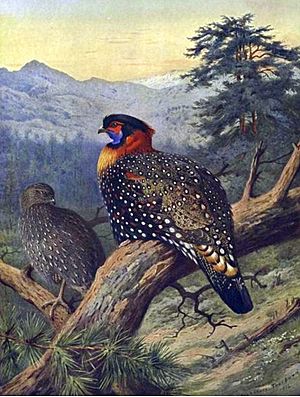Western Tragopan facts for kids
The western tragopan or western horned tragopan (Tragopan melanocephalus) is a beautiful, medium-sized pheasant with bright colors. You can find these special birds living in the Himalayas mountains.
Contents
About the Western Tragopan
The western tragopan is a type of bird known for its amazing looks. It's often called the "western horned tragopan" because the males have two fleshy, horn-like structures on their heads. These birds are quite shy and prefer to live in dense forests. They are also known for their unique calls, which sound like a loud, wailing cry.
What They Look Like
Male western tragopans are very colorful. They have a bright red head and neck, with a black face. Their bodies are mostly black with many white spots, which look like tiny pearls. They also have a blue patch around their eyes. When they want to impress a female, they can inflate a bright blue throat wattle, which is a flap of skin under their chin.
Female western tragopans are not as colorful as the males. They are mostly brown with black and white spots. This helps them blend in with their surroundings, which is important for hiding from predators and protecting their nests. Both males and females have strong legs and feet, which help them move around in the rocky, forested areas where they live.
Where They Live
Western tragopans live in the high mountain forests of the Himalayas. You can find them in countries like India, Pakistan, and Afghanistan. They prefer to live in dense, temperate forests, which are forests that have moderate temperatures and lots of trees. These birds usually stay at high altitudes, often between 1,700 and 3,600 meters (about 5,600 to 11,800 feet) above sea level. They like areas with thick undergrowth, which provides good cover and plenty of food.
Their Diet
Western tragopans are omnivores, which means they eat both plants and small animals. Their diet mainly consists of leaves, shoots, seeds, berries, and fruits. They also eat insects and other small invertebrates they find on the forest floor. They use their strong beaks to forage for food, digging through leaf litter and undergrowth. Their varied diet helps them get all the nutrients they need to survive in their mountain habitat.
Life Cycle and Reproduction
The breeding season for western tragopans usually happens in the spring and early summer. During this time, the male tragopans perform special displays to attract females. They show off their bright colors and inflate their throat wattles. After mating, the female builds a nest, usually on the ground or in a low tree. The nest is often hidden among dense vegetation to keep the eggs safe.
A female tragopan typically lays a clutch of 2 to 6 eggs. She incubates the eggs, meaning she sits on them to keep them warm, for about 28 days. Once the chicks hatch, they are able to move around and find food very quickly. The mother tragopan takes care of her young, teaching them how to find food and protecting them from danger. The young birds grow quickly and become independent within a few months.
Why They Are Important
The western tragopan is an important part of the Himalayan ecosystem. However, these beautiful birds are considered an endangered species. This means their numbers are very low, and they are at risk of disappearing forever. The main threats to their survival are habitat loss and hunting. Forests where they live are being cut down for farming and development. People also hunt them for their meat and feathers.
Many groups are working to protect the western tragopan. Conservation efforts include creating protected areas and national parks where these birds can live safely. There are also programs to educate local communities about the importance of protecting these birds and their habitat. By working together, we can help ensure that the western tragopan continues to thrive in the Himalayas for future generations.
Images for kids
-
Sign about Western tragopans near Sarahan, Himachal Pradesh, India
See also
 In Spanish: Tragopán occidental para niños
In Spanish: Tragopán occidental para niños





